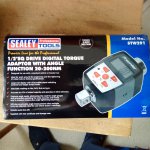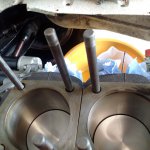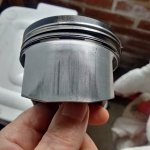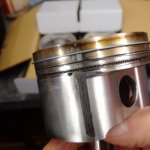Ian,
Sorry to here of your latest mini catastrophy.
I too, reckon that the studs should be installed with the longer thread portion in the crankcase. If the studs are fitted with the shorter thread portion in the crankcase, they will likely protude too far above the cylinder head and have to be shortened to allow the domed cyl. head nuts to fit without bottoming out internally. This might be what has happened on your engine?
My approach is always to try to work with what I have and repair rather than replace if at all possible. This way you get to keep your original crankcase, with the same engine number. You also save the cost of a replacement crankcase, the cost of having it bored out to accept your larger cyl. barrels and possibly a whole lot of time?
With this in mind, another possibility with regards to fixing the stripped crankcase thread would be to have the stud hole welded up, then redrilled and a standard size thread tapped. This would be my preferred solution, but obviously cost and access to someone capable and equipped to carry out this type of repair is a factor unless you can do it yourself.
Re:- use of Helicoil inserts. 10x1.25mm inserts are available and in different lengths but as pointed out above by 'the hobbler'? (Tom) are not a 'common' thread pitch so are unlikely to be found in a kit. The installation tool for 10x1.5mm can afaik be used on 10x1.25mm inserts but you'll need a different tap (i.e. 10x1.25mm) and possibly a different drill to prepare for this tap. Helicoil used to say that a number of inserts can be used together to make up a long thread but best to try to locate a supplier of one sufficiently long insert for this application.
If the cyl. head stud was fitted upside down (i.e. short thread into crankcase) then maybe only part of the thread has been stripped. There may still be enough thread to adequately hold a stud fitted correctly (i.e. long thread into crankcase). Alternatively, it might be possible to gain sufficient thread depth to securely hold a stud by drilling and tapping the hole deeper into the crankcase, but you might then have to source/make a longer stud to fit.
I'd recommend checking all remaining cyl. head studs are installed the correct way up and that there are no cracks around crankcase stud holes.
Re:- the bent pushrod and damaged valve clearance (tappet) adjusting screw. Looks to me to have been caused by the errant cyl. head domed nut becoming jammed between the rocker arm and the rocker (valve) cover. Are there any witness marks on the underside of the valve cover to corroborate this? If so, I'd recommend carefully checking the relevant cam lobe, follower and rocker arm for any further damage. Such components don't take kindly to something effectively becoming' a spanner in the works' and may have suffered stress fractures/cracking. So they need to be checked carefully, if possible employing crack-testing equipment or at least a kit if further problems are to be avoided.
Good luck with the rebuild!
(I think I said this before......)
AL.
Sorry to here of your latest mini catastrophy.
I too, reckon that the studs should be installed with the longer thread portion in the crankcase. If the studs are fitted with the shorter thread portion in the crankcase, they will likely protude too far above the cylinder head and have to be shortened to allow the domed cyl. head nuts to fit without bottoming out internally. This might be what has happened on your engine?
My approach is always to try to work with what I have and repair rather than replace if at all possible. This way you get to keep your original crankcase, with the same engine number. You also save the cost of a replacement crankcase, the cost of having it bored out to accept your larger cyl. barrels and possibly a whole lot of time?
With this in mind, another possibility with regards to fixing the stripped crankcase thread would be to have the stud hole welded up, then redrilled and a standard size thread tapped. This would be my preferred solution, but obviously cost and access to someone capable and equipped to carry out this type of repair is a factor unless you can do it yourself.
Re:- use of Helicoil inserts. 10x1.25mm inserts are available and in different lengths but as pointed out above by 'the hobbler'? (Tom) are not a 'common' thread pitch so are unlikely to be found in a kit. The installation tool for 10x1.5mm can afaik be used on 10x1.25mm inserts but you'll need a different tap (i.e. 10x1.25mm) and possibly a different drill to prepare for this tap. Helicoil used to say that a number of inserts can be used together to make up a long thread but best to try to locate a supplier of one sufficiently long insert for this application.
If the cyl. head stud was fitted upside down (i.e. short thread into crankcase) then maybe only part of the thread has been stripped. There may still be enough thread to adequately hold a stud fitted correctly (i.e. long thread into crankcase). Alternatively, it might be possible to gain sufficient thread depth to securely hold a stud by drilling and tapping the hole deeper into the crankcase, but you might then have to source/make a longer stud to fit.
I'd recommend checking all remaining cyl. head studs are installed the correct way up and that there are no cracks around crankcase stud holes.
Re:- the bent pushrod and damaged valve clearance (tappet) adjusting screw. Looks to me to have been caused by the errant cyl. head domed nut becoming jammed between the rocker arm and the rocker (valve) cover. Are there any witness marks on the underside of the valve cover to corroborate this? If so, I'd recommend carefully checking the relevant cam lobe, follower and rocker arm for any further damage. Such components don't take kindly to something effectively becoming' a spanner in the works' and may have suffered stress fractures/cracking. So they need to be checked carefully, if possible employing crack-testing equipment or at least a kit if further problems are to be avoided.
Good luck with the rebuild!
(I think I said this before......)
AL.
Last edited:







